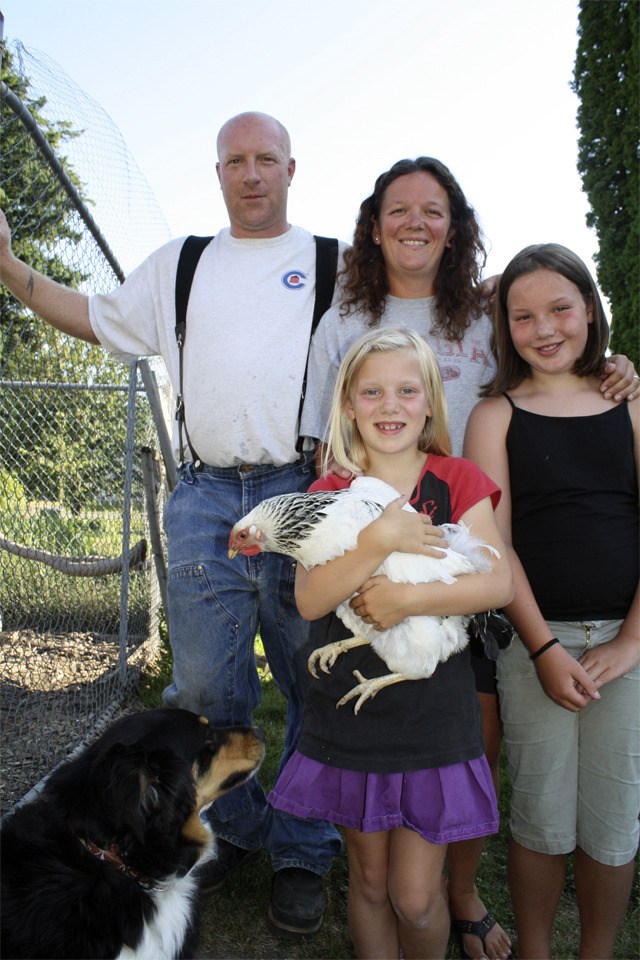Trudy the dog keeps her eyes on the Harrison family’s flock. She noses in for a closer look at a big, white hen. The hen eyes her back, safe on the other side of a layer of chicken wire, then goes back to her business, patrolling a dirt-floored pen for food. Other hens take dust baths, cluck gently, or maintain their pecking order. Several keep their eyes on the nearby Harrisons, hauling in groceries from the car, hoping for a treat.
To dad Ryan Harrison, the best part of owning 11 hens in his Snoqualmie backyard is the entertainment value.
“Chicken TV,” he calls it. “You can sit out here and watch them all day long. They just do their thing.”
For mom Leah, it’s all about the fresh eggs. After getting accustomed to eggs fresh from the coop, storebought eggs look, taste and smell funny.
And for daughters Leah, 8, and Fiona, 7, the chickens are feathered friends. And their human friends love the birds; one playmate ended up with a few hens at her home as a result.
“I think it’s good for the kids,” Leah said. “They learn where eggs come from. They can see them grow from when they’re small.”
Hometown birds
The Harrisons aren’t alone. In their neighborhood, several families keep chickens. While there are pros and cons to raising chickens in suburban Valley neighborhood, the birds, which can be found foraging in yards or, occasionally loose, exploring alleys or parks, seem to be here to stay.
“Many people are interested in keeping chickens,” said Carnation City Planner Linda Scott. “Occasionally, I do get calls” from someone wanting to get some hens. “We go back to the code and figure it out.”
In Snoqualmie and in unincorporated King County, chickens, poultry, squab and rabbits are limited to a ratio of one animal per square foot of coop, up to a maximum of 2,000 square feet. Such animals, however, are prohibited on Snoqualmie Ridge.
In Carnation, residents are allowed four small domestic animals, including chickens, on lots less than half an acre in size, with no more than five additional birds per additional acre.
Carnation’s rule also says that chickens can’t run loose.
Chickens can be a nuisance—they may escape and forage in neighbors yards, sometimes leaving eggs or messes behind. At the Harrison house, chickens stay in the coop during gardening season. Once the garden is done, they get to come outside and explore.
Big fella
The rooster keeps a sharp eye on Mike Morrill. The Snoqualmie resident may own his flock of 15 birds, but this rooster, one of two that Mike owns, is the true boss of this fenced half-yard chicken run.
“Their job is to protect the ladies,” Morrill says. “He does a good job of it. He’s fierce.”
The big, strutting rooster doesn’t have an official name.
“I’ve called him several,” jokes Morrill.
He’ll rush an intruder if it gets too close, and has been known to claw from behind.
The rest of the flock, including the other rooster, is a lot more mellow. The hens spread out across his yard and garden beds. There’s a distinct low-key undertone of clucking, occasionally interrupted by the big rooster’s crowing as he announces his presence.
Morrill has lived on Park Street in Snoqualmie for about three years. This is his first year raising chickens.
“They all have personalities,” Morrill said. When he had his first clutch of chicks, Morrill took the time to handle them, and they got used to him. But when his rooster was a chick, Morrill was in the hospital, so he never had the chance to get the bird accustomed to him. His egg-collecting strategy is to toss in some food, then go for the goods as the chickens chow down.
Raising chickens means a fair bit of work. What with all the chicken feed and care, Morrill figures it’s no cheaper than buying eggs. But the birds are interesting for him.
Without the fence, they’d tear up his garden in their hunt for bugs. His chickens aren’t always confined by his low fence: “They can squeeze through some tight spaces.”
However, if you see a loose chicken on Park Street, don’t assume it’s Mike’s.
“Our neighbor saw a couple of chickens walking down the street, and put them in my pen,” he said. “They weren’t mine.”
Morrill buys day-old chicks and raises them. So far, he’s been unsuccessful in getting his hens to raise new chicks.
“Start small,” he advises. “Start with two or three. Make sure you have time in the first six weeks to take care of them.”
“Definitely research,” Morrill says. “Make sure this is what you really want. There’s a lot of free info out there for everybody.”
He recommends www.backyardchickens.com.



